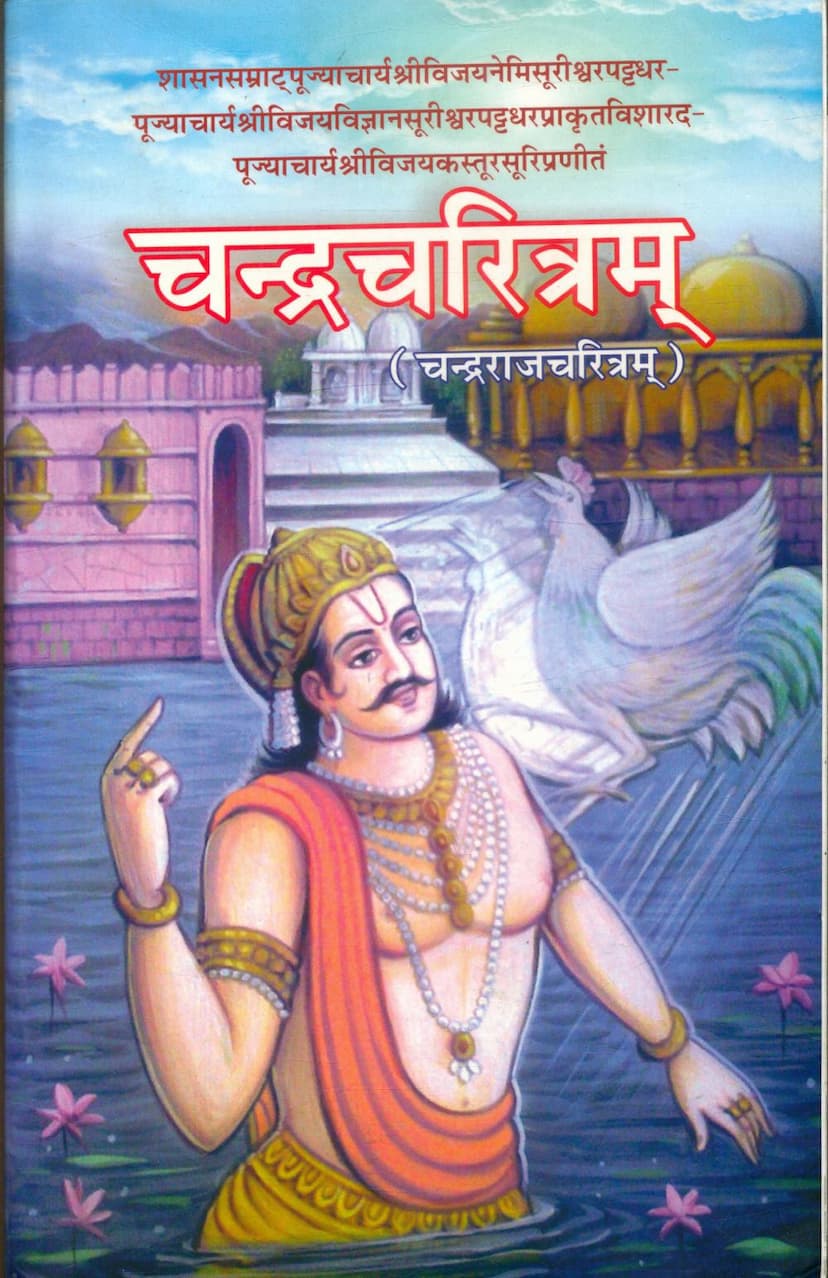Chandra Charitram
Added to library: September 1, 2025

Summary
This document is the Jain text "Chandra Charitram" (also known as "Chandra Raj Charitram"), authored by Pujyacharya Shri Vijay Kastursurishwarji. The text is presented in Sanskrit and chronicles the life and deeds of Chandra Raja (King Chandra).
Here's a breakdown of the key information and themes present in the provided pages:
1. Title and Author:
- Title: Chandra Charitram (also referred to as Chandra Raj Charitram)
- Author: Pujyacharya Shri Vijay Kastursurishwarji
- Dedication: The text is dedicated to a lineage of revered Jain Acharyas, including Pujyacharya Shri Vijay Nemisurishwarji, Pujyacharya Shri Vijay Vignansurishwarji, and Pujyacharya Shri Vijay Kastursurishwarji himself. It also mentions the blessings and guidance of Pujyacharya Shri Vijay Chandrodayasurishwarji and Pujyacharya Shri Vijay Ashokchandrasurishwarji, with the editorial work by Pujyacharya Shri Vijay Shri Chandrasuriji.
- Publisher: Shri Rander Road Jain Sangh, Surat.
2. Content and Structure:
- The book is a narrative poem written in Sanskrit.
- It is divided into several "Sargas" (chapters), detailing different episodes of Chandra Raja's life. The table of contents (Page 20 onwards) lists Sargas covering:
- Pratham Sarga: Mangalashlokas (auspicious verses), description of Jambudweepa, description of the city of Abha, King Veersen, Queen Veermati, the horse, encounter with a yogi, protection of a princess, the princess's narration, her marriage to Chandra, birth of Chandra Kumar, description of spring, Queen Veermati's sorrow over not having a son, the parrot's advice, and Veermati's journey to acquire knowledge.
- Dwitiya Sarga: Chandra Raja's arrival at Vimalapuri, interactions with royal servants, arrival at King Simhal's court, conversations with King Simhala and his minister Himsak, details about King Kanakrath and Queen Kanakvati, the birth of their son Kanakdhwaj, the merchant's tale, and the marriage plans.
- Tritiya Sarga: Chandra Raja is transformed into a rooster, his subsequent experiences, the involvement of his wife Gunavali, and the manipulation by his stepmother Veermati.
- Chaturtha Sarga: Arrest of Simhal and others, teachings of a muni, influence of Navkar Mantra, Veermati's false claims and declaration as ruler, conflict with Hemrath, and the king's advisors.
- Panchama Sarga: Hemrath becomes Veermati's servant, the arrival of Shivkumar Nat and his daughter Shivamala, Chandra Raja (in rooster form) being requested as a gift, Gunavali's lament, and various incidents involving the rooster and its caregivers.
- Shashtha Sarga: King Simhala's interactions, the story of King Kanakdhwaj's lineage and his own transformation, the merchant's role, the supernatural events related to the rooster and its eventual return to human form, and its reunion with Chandra.
- Saptama Sarga: Chandra Raja's return to human form, his reunion with his wife Gunavali, past lives, the influence of divine intervention, the cycle of karma, and eventually, Chandra Raja's attainment of Kevalgyan (omniscience) and Moksha (liberation).
3. Themes and Values:
- Devotion (Bhakti): The text begins with prayers to Jain Tirthankaras (Rishabhdev, Parshvanath, Mahavir Swami) and revered Acharyas, highlighting the importance of devotion in Jainism.
- Karma and Rebirth: The narrative illustrates the consequences of past actions (karma) and the cycle of birth and death, as Chandra Raja undergoes various transformations and experiences due to his past deeds and the actions of others.
- Moral and Ethical Teachings: The story emphasizes virtues like truthfulness, righteousness, perseverance, kindness, and the consequences of deceit, arrogance, and envy.
- The Power of Devotion and Penance: The narrative showcases how devotion to Jain principles and adherence to righteous conduct can lead to overcoming obstacles and achieving spiritual liberation.
- Gurutva (Importance of the Guru): The lineage of Acharyas and their guidance are repeatedly mentioned, underscoring the significant role of spiritual preceptors in Jain tradition.
- The Power of Mantra: Specific mentions of the "Surimantra" and its efficacy suggest the importance of mantras in Jain practice.
- The Role of Women: The text depicts various female characters, from queens and princesses to devoted wives and manipulative figures, showcasing different aspects of feminine roles and influence.
4. Historical and Literary Context:
- The author, Pujyacharya Shri Vijay Kastursurishwarji, was a renowned scholar of Prakrit and Sanskrit literature. The text is noted as a Sanskrit poem, showcasing his mastery over the language.
- The publication date mentioned is V.S. 2070 (2014 CE), indicating a modern publication of a classical text.
- The preface mentions that the Sanskrit composition preceded the Prakrit composition of "Siriyankariyarium" by the same author, highlighting his versatility.
- The text seems to be part of a larger series or tradition of knowledge dissemination by the "Shri Nemi-Vigyan-Kastursuri Gyanmandir."
In essence, "Chandra Charitram" is a rich Jain narrative that combines epic storytelling with profound spiritual and ethical lessons, illustrating the journey of King Chandra through various trials and transformations, ultimately leading him towards spiritual enlightenment and liberation, guided by Jain principles.